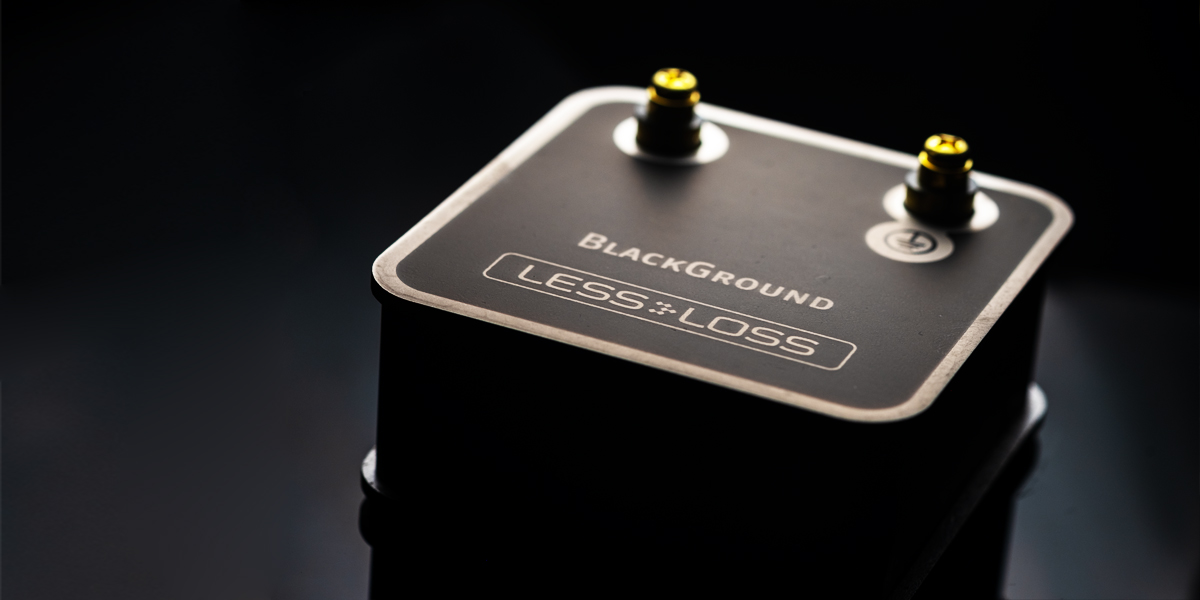The LessLoss BlackGround is the manufacturer’s latest accessory fit for standalone work and as a reinforcement for the BlackBody v2 discs. Now it’s time to tell its story. Enjoy!
Anchor
The LessLoss Blackbody v2 reviewed here in May 2023 was unlike any other product I’ve sampled and for a good reason. These shiny surprisingly hefty pucks resembled jewelry more than anything else. That however wasn’t their key purpose. The Blackbody v2 is a particular passive conditioner type designed to work specifically on the ambient field, not the signal. In a nutshell, it protects our setups from cosmic particle bombardments occurring on sub-atomic levels, so it’s a niche threat far off most listeners’ radar. If you’re raising your eyebrow now, fret not. I’ve been there, too. The Blackbody v2 is one radical and obscure effort no less. Such products are as surreal as it gets, until they’re not. Years back the general consensus was that all CD transports, DACs and streamers were all alike, because hey, zeroes and ones. Cables, anti-vibration isolators, USB sorters and power conditioners were also widely considered as not capable of making an iota of audible difference.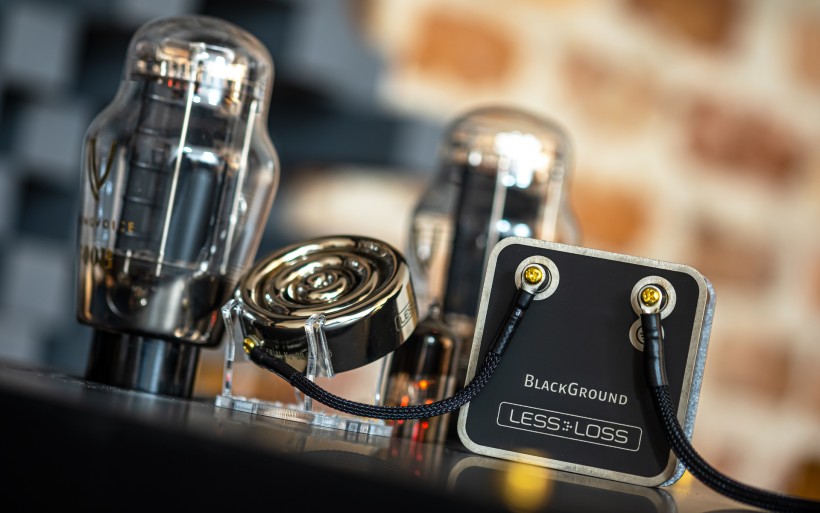 Fast forward some two decades and the entire industry is at a very different place. Audio manufacturers know more, as do listeners, so boundaries of what’s generally acceptable and useful had significantly expanded in the process. These days even network switches often on the job outside the signal path aren’t scoffed upon as hard as they were say a year ago. In this context, the Blackbody v2 is still one of a kind, so even open-minded listeners may find it rather far out. LessLoss did their homework however, so should you wish to know how it works and why, please take a look here. It’s fair to say that the theory behind these discs is rather complex and surely not common knowledge. It addresses an issue not many people are aware of, let alone seeing it as relevant to our audio systems’ performance. In practice, however, a set of five Blackbody v2s had a noticeable impact on sonic performance in my room. Such products far from the mainstream are targeted at a curious audience willing to test their perception and personally investigate whether a small shiny passive object can make any audible difference or not. Today’s story is about LessLoss’ other accessory named BlackGround, that also fits this narrow profile.
Fast forward some two decades and the entire industry is at a very different place. Audio manufacturers know more, as do listeners, so boundaries of what’s generally acceptable and useful had significantly expanded in the process. These days even network switches often on the job outside the signal path aren’t scoffed upon as hard as they were say a year ago. In this context, the Blackbody v2 is still one of a kind, so even open-minded listeners may find it rather far out. LessLoss did their homework however, so should you wish to know how it works and why, please take a look here. It’s fair to say that the theory behind these discs is rather complex and surely not common knowledge. It addresses an issue not many people are aware of, let alone seeing it as relevant to our audio systems’ performance. In practice, however, a set of five Blackbody v2s had a noticeable impact on sonic performance in my room. Such products far from the mainstream are targeted at a curious audience willing to test their perception and personally investigate whether a small shiny passive object can make any audible difference or not. Today’s story is about LessLoss’ other accessory named BlackGround, that also fits this narrow profile.
Prior to moving forward, let me first highlight this article by Srajan published at 6moons.com. Therein LessLoss’ CEO Louis Motek explains that: “BlackGround pairs real-time voltages in the sound system with the ground potential to in effect generate a continuous lower impedance path for the cosmic ionic particle influx to follow. Any electrical discharge always chooses the path of least resistance. That’s what BlackGround represents because it is always at the exact same voltage as the signal. Thus atmospheric noise is dealt with before it interferes with the music signal we want to protect. Because the path follows the signal voltages in real time, we could in fact say that to this cosmic noise the music signal itself becomes the conductor instead of succumbing to being modulated by it. Why more and more BlackGrounds are effective is that each additional unit further lowers this impedance path for less and less intermodulation with the signal.”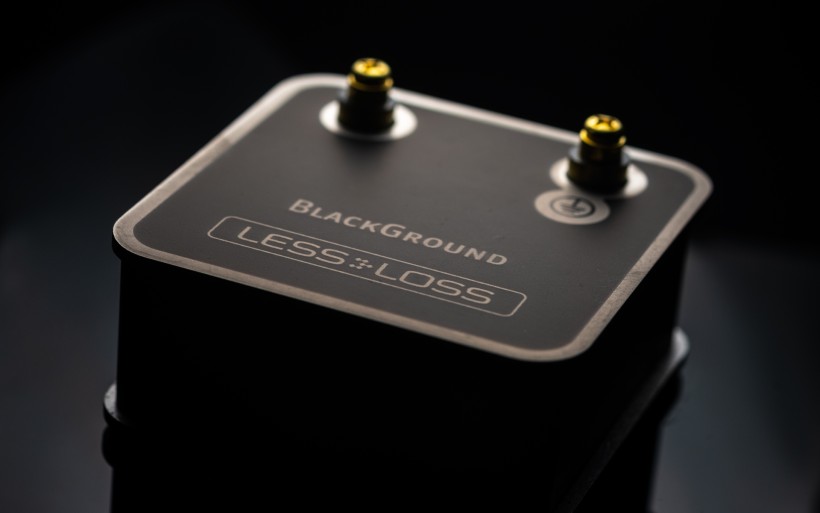 The takeaway from the above is that BlackGround is a passive voltage conditioner that acts as a low-impedance path for noise. This is neither a grounding box nor a current conditioner like the company’s Firewall modules, because no power or signal currents flow directly through it. From Srajan’s review we learn that today’s product essentially taps into the existing real-time voltage regardless of the conductor that carries it. AC or DC, doesn’t matter. Positive, negative and ground channels all happily apply for the treatment. The BlackGround’s unmarked terminal accepts these voltages and then they’re conditioned inside this product’s body in real time, while its ground-marked post connects to the building’s own ground network. This is used as the drain for all the pollution released there. On top of that there’s also the proximity effect. The manufacturer says that the BlackGround already does half its business even when it’s not connected to anything. Its efficacy by just sitting near an audio setup implies action in a way similar to how the LessLoss Blackbody v2 protects it from incoming atmospheric noise. Although wiring individual BlackGround units to BlackBody v2 units to turn them into one interface is highly recommended and hardly a chore, I intended to check their standalone behavior first. Louis informed me that the potency of these blocks compounds, so the more of them are linked, the lower their impedance and higher overall impact on the sound, which seemed an easy thing to investigate. And lastly, LessLoss’ founder also explained that the BlackGround greatly enhances the Blackbody v2’s performance. To him these two products should really go together. Since I had both types at my disposal, that was on the menu as well.
The takeaway from the above is that BlackGround is a passive voltage conditioner that acts as a low-impedance path for noise. This is neither a grounding box nor a current conditioner like the company’s Firewall modules, because no power or signal currents flow directly through it. From Srajan’s review we learn that today’s product essentially taps into the existing real-time voltage regardless of the conductor that carries it. AC or DC, doesn’t matter. Positive, negative and ground channels all happily apply for the treatment. The BlackGround’s unmarked terminal accepts these voltages and then they’re conditioned inside this product’s body in real time, while its ground-marked post connects to the building’s own ground network. This is used as the drain for all the pollution released there. On top of that there’s also the proximity effect. The manufacturer says that the BlackGround already does half its business even when it’s not connected to anything. Its efficacy by just sitting near an audio setup implies action in a way similar to how the LessLoss Blackbody v2 protects it from incoming atmospheric noise. Although wiring individual BlackGround units to BlackBody v2 units to turn them into one interface is highly recommended and hardly a chore, I intended to check their standalone behavior first. Louis informed me that the potency of these blocks compounds, so the more of them are linked, the lower their impedance and higher overall impact on the sound, which seemed an easy thing to investigate. And lastly, LessLoss’ founder also explained that the BlackGround greatly enhances the Blackbody v2’s performance. To him these two products should really go together. Since I had both types at my disposal, that was on the menu as well.
LessLoss offers the BlackGround as a separate DIY unit as well as in four different plug-and-play closed devices dressed in lacquered ply boxes, much as we see in the company’s entry-level Echo’s End DAC. The BlackGround 6x/10x Power Bases are respectively priced at $2’350/$3’942. These house either 6 or 10 individual BlackGround modules within. The BlackGround 8x/10x Speaker Bases sell for $3’096/$3’942, which pack 8 or 10 these blocks respectively. A single unit for DIY applications costs $446. Nine of these were sent my way to test. All the jumper wires ($12/ea.) to connect everything were included in the package. Srajan’s test subject was the 10x version meant for power. The flock of nine I got were individual units without a chassis, just so I could connect them to the Blackbody v2 and find out what happens when used in that application. A standalone BlackGround cube measures (W x D x H) 66 x 66 x 40mm and weighs about 350g, so is surprisingly heavy given its small footprint. It is externally nicely assembled and features a cork base attached to its underbelly. Internals are proprietary. That’s LessLoss’ sweet secret. The BlackGround’s internals, judging by weight alone, are most likely more than a mere circuit board, but I’m just guessing here. LessLoss shares the product’s broad scope of application in practice. They work with speaker signals, line level signals, and all other junctures where any voltages related to ground plane occur. The explanation regarding how exactly to use the BlackGround isn’t necessary here as LessLoss provides handy and detailed connection diagrams online. The general idea is that one threaded post on the BlackGround’s upper part receives a voltage from a source, while the other is to be routed to the building’s ground. This in&out MO means that each unit’s pair of terminals have to remain separate while daisy-chaining two or more modules together. This means each post type is connected in series without crossing them. To put this into practice, a single BlackGround’s ground-marked post sees a cable terminated with a Schuko plug (without live and neutral legs attached) that goes right into an outlet and that’s it. Should you wish to add additional modules, their ground posts simply connect with jumpers, as do, separately, the non-marked posts. Thus, a series of three inter-connected cubes demand a total of four jumpers, four cubes will need six jumpers, and so on so forth. Adding a single Blackbody v2 to that setup needs one extra wire between its own terminal and a BlackGround’s unmarked pin. Simple.
A standalone BlackGround cube measures (W x D x H) 66 x 66 x 40mm and weighs about 350g, so is surprisingly heavy given its small footprint. It is externally nicely assembled and features a cork base attached to its underbelly. Internals are proprietary. That’s LessLoss’ sweet secret. The BlackGround’s internals, judging by weight alone, are most likely more than a mere circuit board, but I’m just guessing here. LessLoss shares the product’s broad scope of application in practice. They work with speaker signals, line level signals, and all other junctures where any voltages related to ground plane occur. The explanation regarding how exactly to use the BlackGround isn’t necessary here as LessLoss provides handy and detailed connection diagrams online. The general idea is that one threaded post on the BlackGround’s upper part receives a voltage from a source, while the other is to be routed to the building’s ground. This in&out MO means that each unit’s pair of terminals have to remain separate while daisy-chaining two or more modules together. This means each post type is connected in series without crossing them. To put this into practice, a single BlackGround’s ground-marked post sees a cable terminated with a Schuko plug (without live and neutral legs attached) that goes right into an outlet and that’s it. Should you wish to add additional modules, their ground posts simply connect with jumpers, as do, separately, the non-marked posts. Thus, a series of three inter-connected cubes demand a total of four jumpers, four cubes will need six jumpers, and so on so forth. Adding a single Blackbody v2 to that setup needs one extra wire between its own terminal and a BlackGround’s unmarked pin. Simple.
In order to use the BlackGround as intended I had to follow a specific protocol. In my experience, these cubes need a full day to settle in, which prevented instant back and forth testing. That’s why if I wanted to use i.e. one module, I had to put it somewhere near my DAC, leave it be for 24 hours, have a listen the next day, then remove it afterwards, and listen one day later. This is why, to do it justice, the entire test stretched over several weeks. Not only this, the BlackGround bodies constantly collect airborne noise that penetrates walls, so after each swap I had to carry them out of my listening room and ideally further from the building to fully nullify their effect. The fact that my setup was constantly powered on during this time was of no real help. Although not being able to do quick A/B comparisons had me out of my comfort zone at first, this turned out a brilliant test of my own perception and patience. My platform hasn’t changed much in the past two years give or take, so its existing sound profile with all its core elements is already etched well in my memory. Just one standalone BlackGround not connected to anything sat atop my DAC and that was the baseline. Then I connected it to the mains ground to see how much of a difference that makes. Then each day one extra cube was added to eventually land a kind of train with nine wagons in total. Lastly, one BlackBody v2 was added to that interface.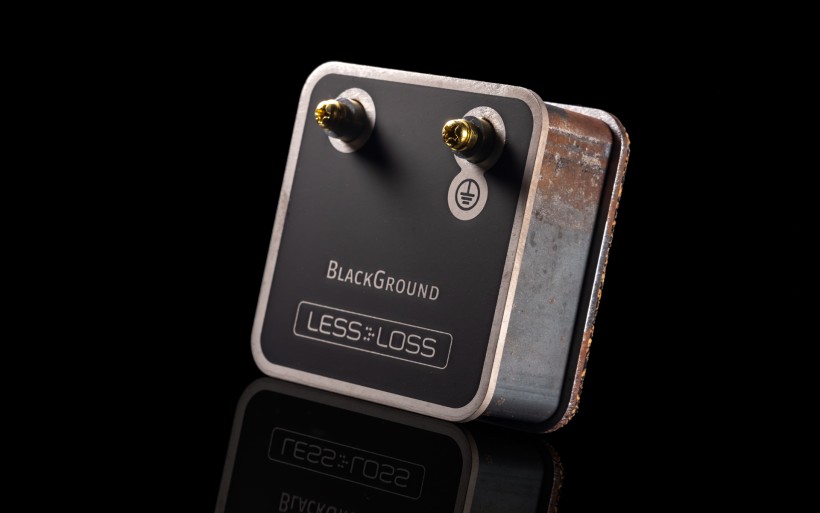 In this BlackBody v2 story I explained how my system’s sound changed with these highly reflective rippled discs on duty: “The entire view grew a touch more anchored and denser, while higher humidity was the most obvious change. The air in-between key sound sources felt rich and fragrant just like before a storm. The overall vibe was less dry and chiseled. Instrumental and vocal shapes struck me as more moist and bloomier than before, while their outlines became somewhat thicker. Sound audibly leaned towards the extra color, boldness and rich aroma rather than twitchiness, sparks, elasticity and high contrast. Increased relaxation and less prickly incisiveness followed. Considering all this, Blackbody V2 was groomed to fit the usual LessLoss noise-killing profile indeed, so enjoyably familiar.”
In this BlackBody v2 story I explained how my system’s sound changed with these highly reflective rippled discs on duty: “The entire view grew a touch more anchored and denser, while higher humidity was the most obvious change. The air in-between key sound sources felt rich and fragrant just like before a storm. The overall vibe was less dry and chiseled. Instrumental and vocal shapes struck me as more moist and bloomier than before, while their outlines became somewhat thicker. Sound audibly leaned towards the extra color, boldness and rich aroma rather than twitchiness, sparks, elasticity and high contrast. Increased relaxation and less prickly incisiveness followed. Considering all this, Blackbody V2 was groomed to fit the usual LessLoss noise-killing profile indeed, so enjoyably familiar.”
Therein it also says that: “Although five BlackBody v2s behaved along the lines of other LessLoss accessories meant to act the part elsewhere, it wasn’t quite the same. It steered sound in my room mainly towards relaxation and softness, while i.e. C-MARC power cables or external Firewall filters did that aside other things, so their input was wider and more universal. “Feel Good Hit of the Summer” by QOTSA and “Run Londinium” from King Arthur: Legend of the Sword are two examples of intense angry fare, with Blackbody v2s presented a touch lazier and calmer than it normally is. That said, they inject tone and gravity at a somewhat higher cost paid in immediacy and dynamic scale versus other LessLoss products. If your setup is predominantly syrupy, thick and cozy and you like it just the way it is, these round passive pucks simply aren’t for you.”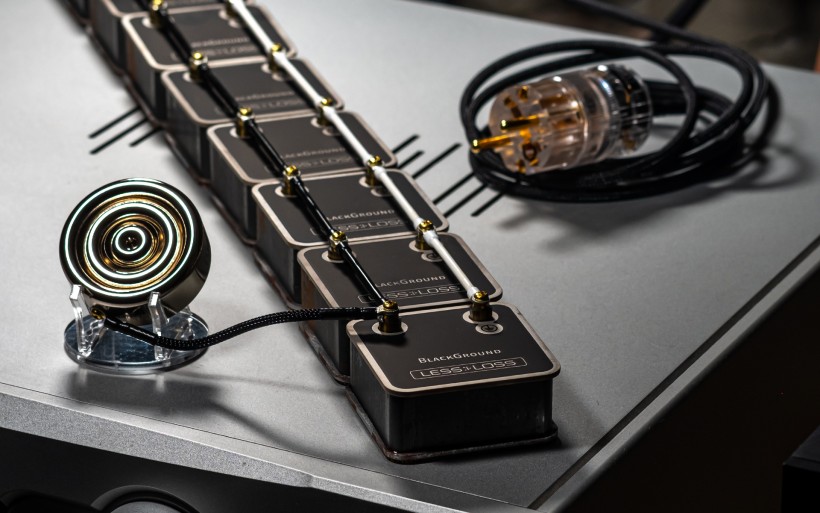 After several weeks spent with an army of BlackGrounds, the sensation was as if their contribution in my room was very much akin to the BlackBody v2’s general influence. The former also proved itself as a noise-killer type for sure, so a device groomed for backdrop blackness and all other well-known upshots; higher density, contrast ratio and smoothness. The twist came in the form of all the extra softness, reverb, spatial order and tone, particularly audible in the upper band. Other noise trimmers I’m aware of didn’t boost these traits as much as the BlackGround. The delta of these changes in my setup had me quite surprised, mainly because it already incorporates a number of passive measures meant to combat incoming noise and clean up all its junctures from any residual glare and spikes. That’s why prior to trying BlackGrounds I already viewed my existing platform as fully cured and pristine on that specific front. It wasn’t. There was still room for more.
After several weeks spent with an army of BlackGrounds, the sensation was as if their contribution in my room was very much akin to the BlackBody v2’s general influence. The former also proved itself as a noise-killer type for sure, so a device groomed for backdrop blackness and all other well-known upshots; higher density, contrast ratio and smoothness. The twist came in the form of all the extra softness, reverb, spatial order and tone, particularly audible in the upper band. Other noise trimmers I’m aware of didn’t boost these traits as much as the BlackGround. The delta of these changes in my setup had me quite surprised, mainly because it already incorporates a number of passive measures meant to combat incoming noise and clean up all its junctures from any residual glare and spikes. That’s why prior to trying BlackGrounds I already viewed my existing platform as fully cured and pristine on that specific front. It wasn’t. There was still room for more.
Most noise cleaners I’ve tried didn’t steer my system’s sound towards any new direction to rework its general gestalt. Rather, their universal action narrowed down to complimenting the sound aesthetic that was already there and largely preserving it. Blackbody v2 isn’t like that considering what it does and BlackGround even less so. The latter proved even more effective and commensurably more situational because of that, so its application and usefulness will depend on one’s own taste, reference points and subjective needs. If your setup is predominantly built upon color, heft, calmness, dim atmosphere, thick outlines and intimacy, today’s device will reinforce these traits. Then it’s up to your ears to decide whether this is too much of the same or not. Conversely, BlackGround is a terrific grit remover and tone injector, so I consider it a spot on addition to systems geared for speed, lucidity, air, openness, vigor, chiseled sound sources and moderate textural fill. Yes, these cube takes some of the snap, bite, edge and outline sharpness away, but that’s a fair trade given all the aspects they boost and how meaningfully. To encapsulate BlackGround’s action in practice, please imagine that one day the sound in your room seems somewhat matte, harsh, ethereal, overly contoured, tense and abnormally twitchy. The next day the same setup sounds just right from the get-go and is free from audible culprits you’ve noticed the other day. 24 hours later they’re all there, again. Rinse and repeat for three weeks or so and that’s pretty much exactly how my experience with introducing and removing the BlackGround went. Good days were those when these devices were connected to the mains and one BlackBody v2 and positioned near my DAC. The time they spent in their tiny cardboard coffins inside my car’s trunk marked bad days. That’s the simplest conclusion I have after having lived with LessLoss’ latest conditioners for quite a while.
To encapsulate BlackGround’s action in practice, please imagine that one day the sound in your room seems somewhat matte, harsh, ethereal, overly contoured, tense and abnormally twitchy. The next day the same setup sounds just right from the get-go and is free from audible culprits you’ve noticed the other day. 24 hours later they’re all there, again. Rinse and repeat for three weeks or so and that’s pretty much exactly how my experience with introducing and removing the BlackGround went. Good days were those when these devices were connected to the mains and one BlackBody v2 and positioned near my DAC. The time they spent in their tiny cardboard coffins inside my car’s trunk marked bad days. That’s the simplest conclusion I have after having lived with LessLoss’ latest conditioners for quite a while.
If the BlackGround were a preamp, it would be Pass Labs XP-22 not Trilogy 915R. As a power cord it’d match the profile of Boenicke M3 rather than Ansuz Mainz A2. Since it puts juicy, dense and sensual qualities above directness, articulation and acceleration, in a way it anchors a system’s sound to make it more grounded and less shiny. More importantly, BlackGround’s positioning among regular hardware isn’t accidental either. Although obscure and non-critical by any means, this accessory did a lot nonetheless. One unit alone didn’t communicate its presence as clearly as i.e. proper isolators under my DAC or pre, but a row of five connected to the outlet multiplier did. Add one BlackBody v2 to that and its main effect becomes reinforced to a point where it’s no longer subtle. A whole extra tier of treble finesse is then achieved on top of all the other benefits. BlackBody v2 doesn’t need nine of these cubed troopers to get going. Just one proved enough to meaningfully amplify the shiny disc’s performance in my room. That’s why if I were a shopper interested in trying out today’s product, my order would also include one BlackBody v2.
It’s fair to say that the BlackGround isn’t meant for skeptics who need measurements to know whether such accessories make any audible difference or not. If you’re in that group, I’m afraid that you’ve wasted your time. Meanwhile, adventurous listeners who rely on their cognitive skills and have all key bits of their setups sorted may want to give the BlackGround a shot. This is one of the most potent accessories in the LessLoss portfolio right now and particularly surprising when paired with BlackBody v2. Now that you know it exists, hopefully this review proved at least somewhat useful as yet another data point of what you might personally experience.
Associated Equipment:
- Amplifier: Trilogy 995R, FirstWatt F7, Enleum AMP-23R
- DAC: LampizatOr Pacific (KR Audio T-100 / Living Voice 300B + KR Audio 5U4G Ltd. Ed.)
- Speakers: Boenicke Audio W11 SE+, sound|kaos Vox 3afw
- Transport: Innuos Statement, fidata HFAS1-S10U
- Preamplifier: Trilogy 915R, Thöress DFP
- Speaker cables: Boenicke Audio S3, LessLoss C-MARC
- Headphones: HifiMan Susvara
- Speaker signal conditioning: LessLoss Firewall for Loudspeakers, Boenicke ComDev
- Anti-vibration conditioning: 12x Carbide Audio Carbide Bases (under DAC, preamp and speakers)
- Interconnects: LessLoss Entropic Process C-MARC, Boenicke Audio IC3 CG
- Power components: Gigawatt PC-3 SE EVO+/LC-3 EVO, LessLoss C-MARC, LessLoss Entropic Process C-MARC, Boenicke Audio Power Gate, ISOL-8 Prometheus
- USB components: iFi audio Mercury3.0
- Rack: Franc Audio Accesories Wood Block Rack 1+3
- Network: Fidelizer EtherStream, Linksys WRT160N
- Music: NativeDSD
Retail prices of reviewed components in EU (excl. VAT):
- LessLoss BlackGround: $446/ea.
- One jumper wire: $12/ea.
Manufacturer: LessLoss


